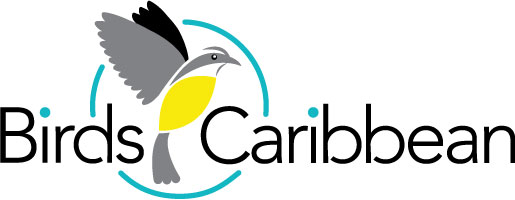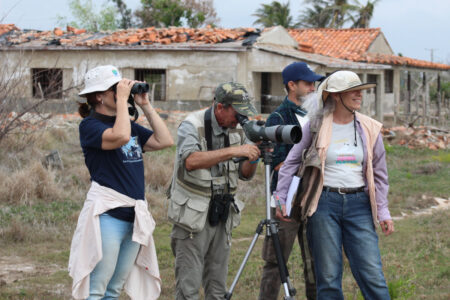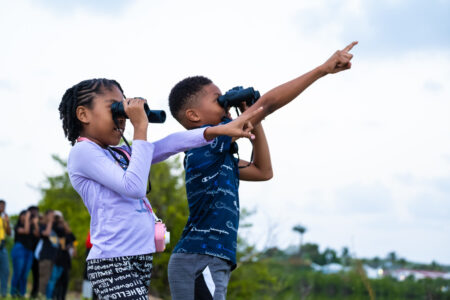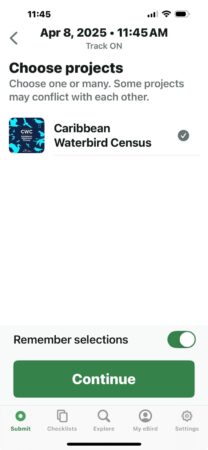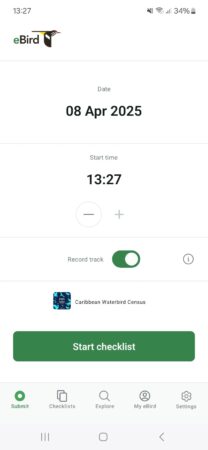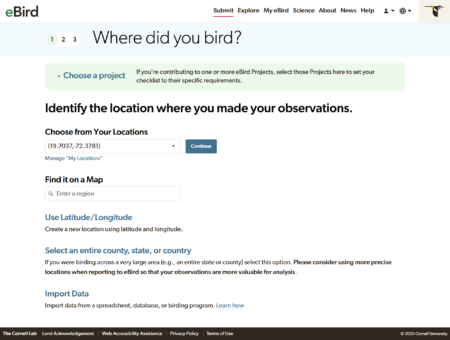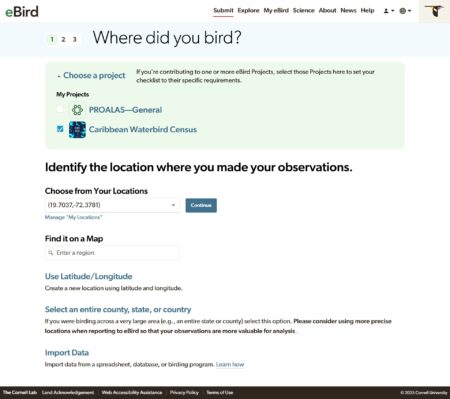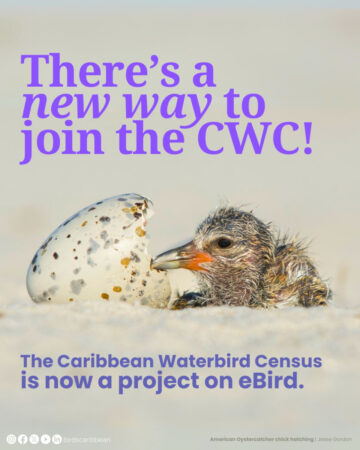 We have exciting news about how to participate in the Caribbean Waterbird Census (CWC) using eBird! Whether you’re a long-time contributor to the CWC, use CWC protocols in eBird, or are just getting started with waterbird surveys in the Caribbean, there’s now a better and easier way to ensure your data is added to this incredible long-term program!
We have exciting news about how to participate in the Caribbean Waterbird Census (CWC) using eBird! Whether you’re a long-time contributor to the CWC, use CWC protocols in eBird, or are just getting started with waterbird surveys in the Caribbean, there’s now a better and easier way to ensure your data is added to this incredible long-term program!
The Cornell Lab of Ornithology has launched a powerful new feature, eBird Projects, that makes it easier than ever to take part in targeted data collection efforts like the CWC. If you’ve contributed to our amazing 16-year citizen science database using the CWC protocols in eBird in the past, the process has now changed slightly in eBird.
You no longer need to search the dropdown menu for CWC protocols in the “Other” options. Now, simply join the CWC project in eBird and select “Caribbean Waterbird Census” from your projects when starting a new checklist. This ensures your counts are properly tagged and included in the official CWC database. Read on for step-by-step instructions for both the eBird app and website. You can also learn more about eBird Projects here.
How to join the CWC Project
Great news—if you’ve ever submitted a checklist using a CWC protocol—you’ve likely been automatically added to the project! Check out the CWC project pages here to confirm you’ve joined, explore CWC stats, see the latest checklists, and meet our “Top CWC eBirders.” If for some reason you’ve not been joined, just go to the ‘about’ section on the project page, scroll down, and click “Join Project.”
New to CWC? No problem! Just visit the CWC Project Page and click “Learn how to join.” Review the info about the project, scroll to the end and then click “Join Project.” If you are not logged into eBird you will be prompted to “Login to Join Project.”
Anyone can join—we welcome new contributors!
Make sure your checklists count as CWC!
Once you’ve joined the CWC project, it’s easy to add your CWC lists to our database on the eBird app or on the website. Here’s how:
CWC in the eBird Mobile App
IMPORTANT: Projects are only supported in version 3.1.3 or later of the eBird app. If you’ve joined a Project but are not seeing it on eBird Mobile, go to Settings>Check for updates in the app—you may need to update in the Google Play Store (android) or App Store (iPhone). Project options will not appear immediately after the update, you will need to wait for a few minutes before you see this.
Once updated:
- Launch the app.
- Tap “Choose projects” above the “Start checklist”’ button.
- Select the CWC project, and, if you like, ask the app to remember this choice for future submissions. If you do this CWC will appear automatically above the “Start checklist” button next time you use App.
- Tap “Continue” and do your count (it’s that simple!)
- Next time you do a count at a Caribbean wetland, select “Caribbean Waterbird Census” above the “Start checklist” button.
CWC on the eBird Website:
- Go to the Submit page.
- Use the “Choose a Project” dropdown to check the box next to “Caribbean Waterbird Census.”
- Then follow the steps below to add your list details as normal.
For your CWC lists, be sure to:
- Do a complete checklist of all birds you were able to identify by sight or sound (to the best of your ability). Check out why this is important and best practices for ebird here.
- Select the appropriate protocol (Traveling or Stationary) before submitting.
Now that you’ve joined the project, you can easily identify which of your eBird checklists are part of the CWC! Just view your checklists in eBird—those included in any eBird project will display a small green circular icon in the upper right corner.
Click on the list to see details, including which project it is associated with.
What happened to the CWC Area Search Protocol?
The CWC Area Search protocol was previously available for counts where it was possible to move through the habitat on a predetermined route to count all the birds in the area. Now that eBird allows you to enter the survey area size manually as part of a Traveling Count, this separate protocol is no longer needed. If you previously used Area Search, we recommend switching to the CWC Traveling Count—especially for sites with trails, boardwalks, or navigable waterways. Just be sure to enter the Surveyed Area (in hectares or acres) in your checklists!
Where in the Caribbean does the CWC take place?
The CWC Project Region* includes:
- Bermuda, The Bahamas, Greater and Lesser Antilles
- Aruba, Bonaire, Curaçao, Trinidad and Tobago
- Providencia, San Andrés, Swan islands
- offshore islands and cays of Venezuela.
*Only checklists from within our region can be added to the CWC Project in eBird.
What habitats should be covered by CWC counts?
Any accessible wetland in the CWC region can be surveyed using CWC protocols, including:
- Mangroves, salt ponds, freshwater swamps, marshes, lagoons
- Bays, beaches, mud flats, sand flats, estuaries
- Canals, farm ponds—even sewage treatment plants
Every wetland, regardless of size, contributes valuable data. We especially encourage surveys at wetlands with protected status or special designations, such as RAMSAR Wetlands, Important Bird Areas (IBAs), and Western Hemisphere Shorebird Reserve Network (WHSRN) sites.
Need help?
For general help with eBirds projects (joining/ leaving projects, editing checklists, etc.), visit the help page on eBird.
If you have questions specifically about joining the CWC project, using the CWC project pages, or the CWC program at large, reach out to our Waterbird Program Manager.
Why your participation matters
The Caribbean Waterbird Census is a long-term region-wide initiative to track birds using Caribbean wetlands, identify the threats they face, and raise awareness. Your data plays a critical role in shaping conservation actions and priorities across the Caribbean.
The CWC has compiled thousands of checklists—thanks to YOU! Visit our CWC eBird Project Page to explore the impressive stats and see the top contributors.
While the annual regional count takes place from January 14 to February 3—providing a valuable winter snapshot—CWC counts are important year-round, especially during fall and spring migration. Whether you’re monitoring resident or migratory species, every count matters.
If you’ve never done a CWC count before, now is the perfect time to start. Just remember to select the CWC Project in eBird every time you do a count at a Caribbean wetland.
Need help identifying shorebirds and waterbirds? Check out our resources page as well as waterbird and shorebird ID webinars and short ID videos on our YouTube!
Learn more about the CWC program HERE.
